
Few nations evoke controversies on the level Cuba does. From romantic praises to intense denouncements the largest Caribbean country leaves few undecided. Every journey to Cuba is “ideological tourism“ in a sense showing the visitor an economic system which is so different from what a Westerner is used to. Indeed the differences in system were more interesting for me than the relatively simple provincial towns and scenery.
The „heroes of 1959 Revolution“ are however aging rapidly and so is the communist Revolution itself. Fidel Castro ceded his power to younger brother Raul after becoming the longest serving non-monarch head of state ever. But that could only buy a few years (Raul, born in 1931, is only 5 years younger than Fidel) and further transformations are going on over what was (is?) known as the „Island of Freedom“.

A typical square-front rooftop slogan declaring Always to the victory (Camaguey).
Cuban roads are history books
In most countries, the arrival night offers little surprises. In Cuba, they begin at the airport hall where a drug dog is seemingly the busiest of many employees. To find the car hire office we have to ask people around and they point us to a small backdoor lacking any adverts. All four Cuban car rental companies are state-owned so there is no competition and no need for marketing.
Our ride from Holguin airport to downtown hotel proves even more interesting. For in Cuba every road is a history book that spans a century. Pre-revolutionary American cars of long-extinct marquees are part of Cuba‘s image. Kept in awesome condition since 1940s or 1950s they remind of the lavish era under Fulgencio Batista when Cuba housed large hotels and casinos that catered to rich Americans. These had been the times that the Revolution ended but – ironically – also preserved them in streets by making acquisition of new vehicles too expensive for most Cubans and forbidding resale of used post-1959 vehicles.
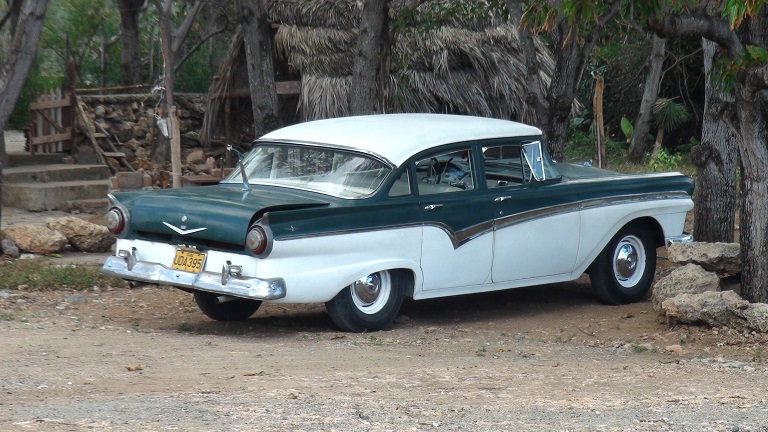
A bicolored axample of so-called Detroit Baroque. Such cars are called Yankee Tanks.
Throughout 1960s-1980s Cuba was allied to the Soviet Union. To support the „vanguard of communism in the Americas“ Soviets exchanged their industrial products for Cuban sugar at below-market rates. This included thousands of Lada and Moskvitch automobiles distributed to Cubans through limited allowances. The junky Soviet cars outnumber older American ones but they are sold at a price of merely 30% of the latter.
And then there are all the horses and bicycles, almost invisible at night. After the Soviet collapse an average Cuban monthly salary (~15 Convertible Pesos) could buy merely 10 liters of fuel. Cubans then turned to previous centuries for inspiration. The carriages now once again serve as public transport. Some hail this as an “ecological milestone” but the horse feces on streets reminds of the 19th-century newspaper articles that promised imminent “ecological disaster” due to massive horse traffic.
Other Cubans ride in cramped trucks (packed by people where cargo should be) that traverse routes which are nowhere listed but seemingly known to everyone. Tourists, on the other hand, are provided with modern Chinese buses and Western rental cars (distinguished by red license plates). Detractors call such policies “Tourist apartheid“ but it became a necessity after the lean „Periodo especial“ of the 1990s. With the Soviet “older brother“ dead here too Castro looked decades back for a solution to somehow survive. And he decided to restore the Batista‘s tourism business.

A passenger truck in Cuba.
In Cuba the client is never right
The „Client is always right” mantra that prevails in the West is completely overturned in socialist countries including Cuba. There are no private companies meaning that employees and CEOs alike are equally disinterested at providing good service. After all, the fewer clients there is, the less work there is to do (and salary remains the same while the job is guaranteed by state). So a three-person long line at Holguin hotel reception desk the first night ends up causing a 30-minutes wait.
During this time several touts approach us offering to stay at their homes instead (for a fee of course). During my week in Cuba, this is to become a common experience. Hotel staff openly condones it. In one case the receptionist directly told me that it is better to stay at a private home. Another receptionist in the same city lied that his hotel was full (vacant rooms suddenly ”appeared” only after the local touts described their cheaper proposals). In Cuba, nobody cares for the state income save for a few members of Revolution Defense Committees while the homeowners‘ private income is illegally shared with hotel workers.

In low-res images the Cuban state hotels look better than in reality (Holguin hotel).
Room rental business (”casa particular”) has been legalized only a few years back but it is now thriving with thousands of windows marked in its peculiar sign. Most Western tourists in Cuba have a very different vacation than me and stay at all-inclusive resorts. This leaves few potential users of casas but room rental business is still lucrative as a single night costs more than an average Cuban wage (25 – 30 Convertible Pesos).
So casa owners and hired touts use every mean possible to lure tourists including widespread lies. An „en-suite toilet“ might turn out to be a restroom shared by two rooms while an offer of a casa for 4 people may turn out to be two double rooms in separate homes at separate districts of the city. After these experiences, we opted to stay at state-run hotels for most nights. These decaying „200-room monsters of concrete“ are usually unclean. But their strongpoint is fixed rates of 40-45 Convertible Pesos per double room (regardless of whether you are in Havana or some small provincial capital) and a generally uniform quality meaning you always know what to expect.

Pizzas are prepared here at a local state-run restaurant (Gibara, north of Holguin).
Drive through the Cuban eastern countryside
We visit Cuba by rental car which is the best way in tight schedule. Eastern Cuba, the heart of Afro-Cuban culture is our first goal. Census reports 65% Cuban people as White yet other sources claim the same 65% as Black Afro-Cubans (descendants of former slaves). White is prestigious in Cuba so whiter Mulattos report themselves as White while lighter skinned Blacks report themselves as Mulatto in censae. Some sources claim that as much as 95% of Cubans are actually multiracial, meaning that many families have people of various skin shades.
While driving through Cuban plains I learn that most Cuban buildings lack glass completely. Instead, the windows are covered by unique metal horizontal shutters. When open they make the wind come through, when closed they completely darken the interior.

These five Cuban intelligence officers arrested in the USA for espionage and murder are held as national heroes by Cuban government. Their pictures are among the most popular propaganda posters (available in many places from main squares to banks).
Unlike elsewhere in Catholic lands the churches do not architecturally dominate towns and villages. It is partly a consequence of once atheist Castro rule (spectacularly ended with Pope‘s visit in 1998), which left many churches ruined, and partly related to the popularity of semi-Christianised African religious traditions (Santeria, Palo Monte, Abakue secret society). These faiths „unite“ African pagan gods and goddesses with particular Christian saints in the same way Romans equated their gods to Greek ones. The African cults are home-based while the Catholic churches are typically locked outside mass giving few opportunities for religious visits.
Basilica del Cobre, the heart of Christian Cuba, is, however, meticulously well kept. Well before its village on the road to Santiago we see people selling flowers as it is a tradition to bring them there. The 1927 church stands on a small hill over a valley. Inside some 10 or 20 people pray. The votive offerings on the walls include baseball equipment and revolutionary insignia: a striking reminder that 1959 revolution was not initially communist. It was supported by a broad anti-Batista movement which even included priests but after the hated regime was deposed Fidel Castro consolidated power.

A booth selling yellow flowers on Basilica Del Cobre approach.
Santiago, the Arican heart of Cuba
Santiago De Cuba (pop. 400 000) is the country‘s second largest city and the heart of the East and also the first city of Cuba I explore. It meets me with meticulous facades, propaganda posters, a smelly smog of aging car engines and beggars. Even the beggars in Cuba are different as many demand particular things instead of money: pens, shampoo, cosmetics.
In a socialist economy, some things which the Westerners consider so simple are almost inaccessible to the general population. The first thing we do in Santiago is a search for a bank to exchange Euros to local currencies. Yes, currencies, as there are two of them: National Peso is the one people receive salaries in; prices are low but few goods are available in this currency. Convertible Peso shops offer better assortment but are out of reach for most Cubans as the prices there are comparable to Western ones.

A takeaway restaurant which accepts National Pesos. Most of them look third world while Convertible Peso restaurants have better image.
However, if you believe that you are helping a needy Cuban by handing out him a pen he asks for – you are likely very wrong. Every Cuban in contact with tourists is already among the richest in supposedly „classless“ socialist society (this forces even doctors and teachers to take taxi driver and barmaid jobs). The coveted pen will not be used by the beggar‘s son in school. It will be illegally resold to fellow Cubans who lack tourist contact. This all becomes too clear when one beggar answers our counter-offer to exchange our pen into something of his own by angrily demonstrating the great number of pens he already received from tourists that day (“Why should I exchange, tourists give me pens for free”).
In Cuba, the crumbling is always right next to the meticulously restored. The restored Santiago main square (flanked by a cathedral and municipal balcony where Castro told his first public speech) is surrounded by districts full of abandoned homes some of them marked with Peligro! Derrumbe! signs (Danger! Collapse!). This is no small deal and tens of people die annually in these collapses, the true death toll being hidden by official media yet passed on by the word of mouth alone.
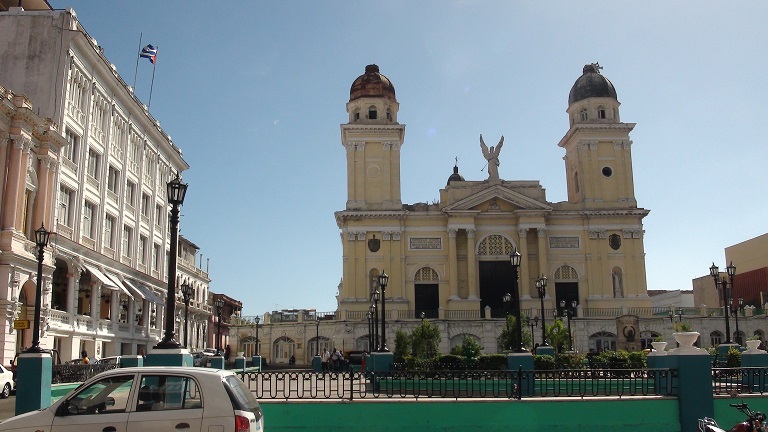
Santiago main square.
Santiago was the birth of the Revolution in many ways. Moncada barracks we walk near was the first (unsuccessful) target of Castro in 1953 (now a school). The city is full of communist slogans and artsy depictions of revolutionaries – just as anywhere else in Cuba. Some slogans are universal, others seemingly radical (“Socialism or death”) and yet others praising particular leaders (e.g. a quote by Fidel about Che Guevarra). The sculptures are typically concrete megalomania. Like every other city, Santiago has its own Plaza de Revolucion, a vast open field with massive political statues. Santiago complex of 23 gigantic machetes and general Maceo dwarfs most of its counterparts.

Sculpture near the Mocada barracks.
Hurricane-struck Baconao National Park
Afternoon in smoggy Santiago makes us wish for clean air which we find in the Baconao National Park nearby. The park is inhabited but its hills provide nice vistas of the otherwise lowland country. We visit coffee plantations nationalized from their French-Haitian owners after the Revolution. Now overgrown the home still has period furniture although the historical presentation is ideologised mixing up the 1800s slavery era with that of 1950s capitalism. We have to walk the final kilometer to the plantation as the road is too bad for our 2WD car. As the caretakers tell us tourist buses fail to get even that far leaving the place almost touristless. Indeed, we do not see any other visitor while there.
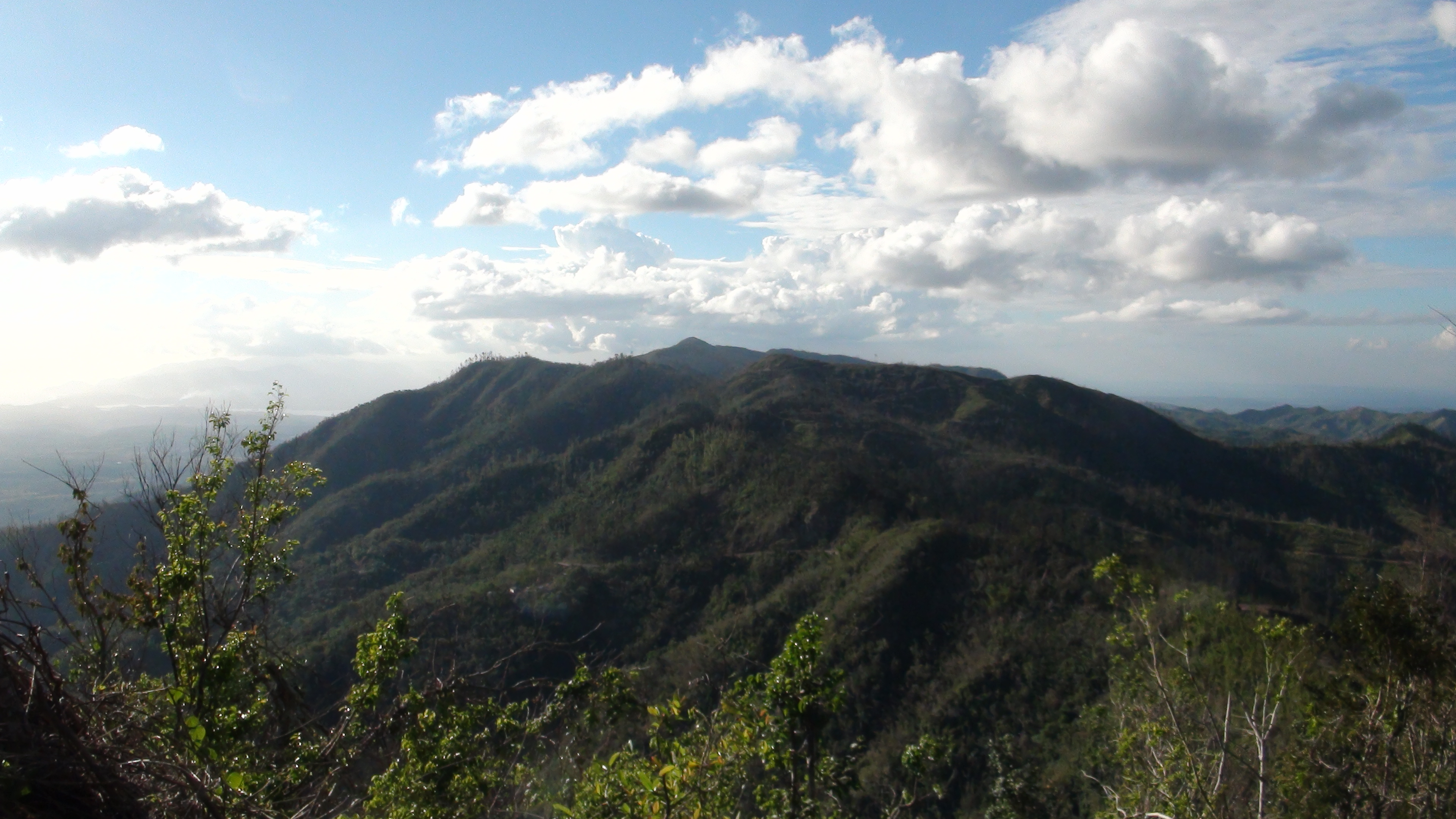
Vistas at the Baconao national park.
The park also includes a zone of massive roadside Soviet sculptures and a beach. All these have been damaged by a hurricane 6 months ago, a yearly occurrence in the Caribbean. “Entire buildings have been washed up” – we are told by a typical “unofficial guide” who came after we stopped our car hoping to get some Convertible Pesos.
Next morning in the nicely-restored state-run hotel of central Santiago I open the glassless window and see numerous biplanes overflying the crumbling Santiago roofs at a low height. This was a Soviet An-2 which had its first flight in 1947. In that gone-by era when Germany and Japan were still occupied by the World War 2 Allies and Africa scrambled by French and British. Morning breeze blows into my face while the memories of night-time street chants advertising (illegal) sales of Western-branded cigarettes still echoes in my head. That moment I understand why it is so easy to idealize Cuba, an island where history surrounds you unlike anywhere else and the now-unique socialism is joined by Latin passion rather than by Russian coldness.

An-2 circles over Santiago at dawn.
However, my own internal knowledge of Soviet Union system would never allow me to consciously think this way. As one Cuban director told during a documentary film festival I attended in Vilnius – „when Westerners say that Cuba should remain unchanged because they like it this way they inadvertently consider Cuba as some kind of zoo and not think that people have to live there“. After all, the difference of Cuba is not a longstanding cultural one (unlike e.g. in the Islamic world) but rather introduced by a group of revolutionaries in a period of several years in the 1960s. Many Cubans disagreed with it and some 10% already fled their country for the USA despite unbelievable dangers (among them prison, death by sharks and forced return to Cuba for a life worsened further).
Santiago de Cuba has a carnival which Cubans believe rivals that of Rio de Janeiro. We visit at a wrong time but a visit to Carnival museum is our goodbye to the city. Many costumes are shown there with African, Chinese and European influences. Recent ones are ingeniously made out of the trash to save money. We almost miss it all, however. While walking to the museum a local person becomes our unwanted guide. He lies to us that the museum is not yet open and offers an (illegal) city tour. In that “Only in Cuba” fashion both museum workers suddenly confirm that the institution is not yet open and suggests returning after the guided walk (most likely hoping to share the “guide’s” tips). When we show the well-printed opening times on the entrance they agree to sell us tickets (after mentioning that this was “especially for us” and “forgetting” to return the change). It is always nice to help poorer countries (tourism provides 2,5 billion USD yearly revenue to Cuba) but I prefer spending money on goods and services rather than supporting frauds and thieves. While outright robberies are scarce, scams are unfortunately very common in Cuba.

One of the streets of the rectangular grid in the downtown Santiago. Most Cuban city centers are full of similar low-rises.
The wild coast of Santiago
Santiago lies at a bay, its entrance once guarded by a formidable Spanish fortress. Now the fortress is well kept and surrounded by state-run tourist shops. I find the nice views of the bay, an island village and the open ocean to be more interesting than Spanish-only museum inscriptions on various wars and the “North American imperialism”. As elsewhere we are met by beggars – this time a group of uniformed schoolgirls who tell they are hungry and lack food. Later we witness how they spend the tourists’ charity on ice cream in the local expensive restaurant. Most Cubans are indeed poor by Western standards but “poor” in socialist Cuba is not the same as in malnutrition-ridden Sahel. Some basic food, utilities, living space, and education are provided by the state to every citizen almost for free in pre-set periods. Unfortunately, few tourists understand this opting to irresponsibly give out their money to everybody who asks for it, believing the invented stories.

Santiago fortress.
For lunch, we drive to the unpaved coast road west of Santiago. The city apartment blocks give way to open wilderness surprisingly quickly. After almost losing hope we found a single lonely paladar (private restaurant) washed by ocean waves. An old bi-coloured American “road cruiser” is resting nearby and if the recent hurricane damaged anything it has been already restored. Like most other paladars this one provides a menu of three courses without any alternatives. Like elsewhere the meal is too large for me although not delicious. A minute of chewing fails to grind the pork; some of its parts are too hard to even be sliced with a knife. Later I will learn that almost nothing is very tasty in Cuba and the problem likely lies in bad quality of food (especially meat) rather than the recipes. Gourmet restaurants with European chefs in Varadero are little better than the street stalls. A month after returning home I will learn that Cuba finally permitted private wholesale so things are likely to change.
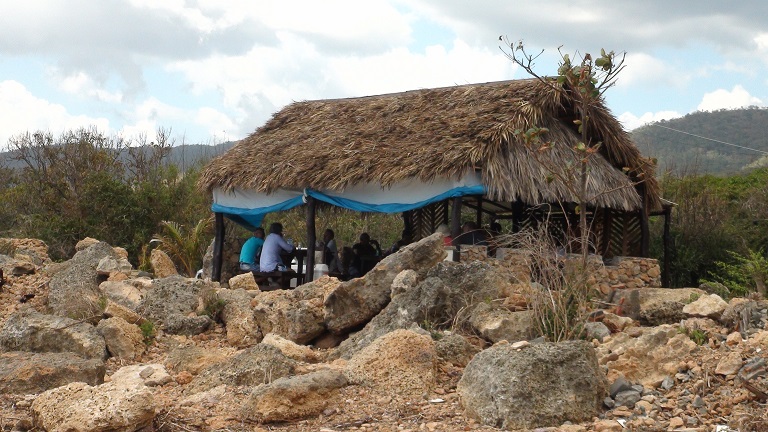
The beach paladar near Santiago.
Before leaving Santiago one of us needs a pharmacy. “Tourist apartheid” prevails here even more than anywhere else. For the Cubans medicines are free – but there are few of them available in the local pharmacies. A hotel worker marks an “international pharmacy” on our newly acquired atlas of Cuba. That one is full of modern medications. But letters on the window declare that the institution is exclusively foreigners-only.
In Cuba, all businesses were nationalized by the Revolution but today in a sense Cuba as a state is a major businessman. Tourism is its business and to attract sun-loving visitors modern amenities are needed. However, under no circumstances could Cuba provide such amenities equally to every Cuban in a socialist way. So it buys them cheaper and sells them at a higher price to tourists earning money (like any businessman would). The profit should then, in theory, be distributed to the population through ordinary means just as the profit of sugar and rum trade used to be when these industries dominated. But tourism is a different kind of export – goods are not moved out. Instead, the clients (temporary) move in. This means a closed country is no longer a solution. Initially “tourist apartheid” was so strict that Cubans who talked to foreigners would have been stopped by police. But today these policies are more and more dismantled.
Major league basbeall in Bayamo, Cuba
In Bayamo we visit a game of Cuba‘s national sport (baseball) for a unique cultural experience. Cuban National Series – the local major league – is nominally amateur but the players are allowed to work less in their official state-owned workplaces meaning it is semi-professional at least. It is among the world‘s strongest and some of its players “defected“ to the USA where they became millionaires at the cost of being barred from the Cuban national team.
Best seats at the Bayamo stadium cost us a mere 1 National Peso (~4 US cents) each. Due to the ongoing cholera epidemic, every spectator has his or her arms sprayed in a chlorinated water on entering. Seats are not numbered.

During the match.
Despite being a local league match the game begins (20 minutes late) with the Cuban anthem. This is more appropriate in Bayamo than everywhere else as its very first lines declare „Hasten to battle people of Bayamo / As the homeland is proudly looking at you“. This is to remind the sacrifice of Bayamians in the doomed 1868-1878 bid for independence (when they torched their hometown to save it from recapture by the Spanish) but today it works for baseball just as well. Stadium‘s score table is surrounded by pictures of Raul and Fidel and their quotations on sport (“Long live the socialist sport of Cuba!”). Local team‘s mascot costume seems to be partly recycled like those from 1990s Santiago carnivals. The fans cheer at the most important moments but are quiet by European standards. A local orchestra brings art into sports field by playing throughout the offensive innings.
With baseball unpopular in my home country, this was the first match we all watched live. Local Granma (named after the province which is in turn named after the boat Castro used to enter Cuba to ignite the Revolution) team defeated Ciego de Avilla 3:2 despite the opposing team‘s home run at the end. Must be a great achievement for Granma as they will lose the next two matches against the same opponents 0:7 and 0:9 (in Cuba the same teams play three matches in a row Tuesday-Thursday presumably to conserve traveling time). Ciego de Avilla are the reigning (2012) champions after all and all three matches are shown live on TV. Like everything else major league baseball is state planned in Cuba and every province has its own single team regardless of its population (with no possible relegation).
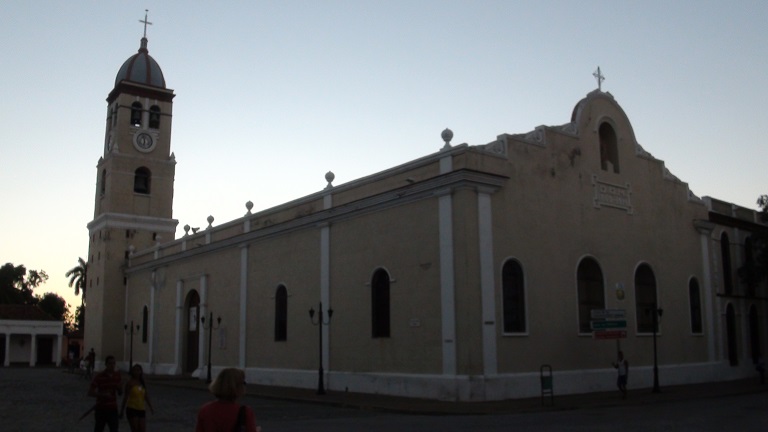
Church in Bayamo's relatively well-kept Old Town.
Holguin and its coast
The coast 70 km north of Holguin is among the Cuba’s state-planned meccas for foreign tourism. Until recently Cubans were not even allowed there and while this is no longer the case the prices would bar most from visiting. I don’t like such international resorts as they are far from authentic and very similar to each other whether in Europe, Africa or America. I believe they are preferred by those who actually don’t fancy traveling but merely hate the winter climate in their home countries (Cuban temperatures approached +30 C throughout our February visit). In Guardalavaca a 1980s hotel stands amidst abandoned smaller buildings, presumably a former resort for Cubans. For the more affluent there are 5 stars hotels too.
A “Taino Indian village” has been constructed for tourists nearby. It boasts low-quality life-sized figures of Amerindians as the true Native Americans have been eradicated in Cuba by European diseases in the 18th century. The nearby necropolis has some of their remains unearthed for all to see but one is unable to feel any connection between Cuba today and this not-so-distant past. Back in my home city, you may still see buildings constructed in the 14th century while here that century was not only another era but another world, extinct like that of the roaming dinosaurs.

Taino Indian Village near Guardalavaca.
An opulent yet decaying colonial port of Gibara – once the Oriente‘s major access to the ocean – proves to be far more atmospheric. A 19th-century church, cinema, and pizzeria at the central square are joined by a cigar factory. I watch the work inside it a little – easy to do as in Cuba even the factories lack windows. A dark portrait of young Fidel Castro overlooks his subjects in the aging premises. Classically decorated buildings remind of the eras gone-by (though not the previous worlds).

A bypasser looks inside the cigar factory where he sees socialist slogans and image of F. Castro.
We stop by a statue of Camillo Cienfuegos that faces the town from the shore. Cienfuegos was another “revolutionary hero”. His premature death in 1959 made him a martyr locally but precluded from reaching worldwide fame of Castro or Guevarra. Now this metal sculpture too is slowly turning into a reminder of a previous era. A staggering 77,9% of all Cubans are born after Cienfuegos disappeared with his aircraft (and therefore after the Revolution). Cuba is changing and it will have to change further. Will all the statues and communist slogans be removed like in Eastern Europe? How long will the cars manufactured when Henry Ford was alive still traverse the Cuban roads?
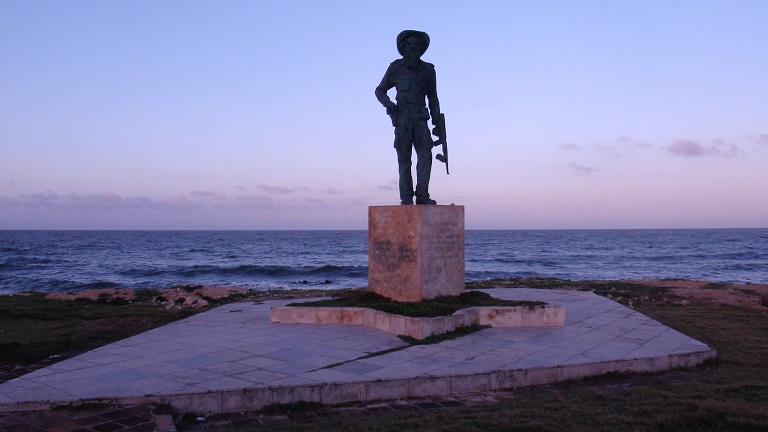
Statue of Camillo Cienuegos at Gibara.
The long road westwards
Cuba is a 1000 km long island and a single central road is its main street. We drive westwards across the plains. Other cars meet us by flashing headlights. This is not a greeting but a warning. In the daytime, it is a warning to turn the lights off (in most of Europe one must keep the lights always turned on; in Cuba, one must turn them off until sunset). In the nighttime, it is a warning to switch to the short lights. However, we always drive with short lights in the night but the Cubans, unused to newer cars, think that we used high beam.
I spend a night at the usual 43 Peso hotel in Las Tunas. After 3 days in Cuba, everything begins to feel familiar. The 30-minute wait at the reception when one receptionist is busy (but another one merely stares at us doing nothing) no longer surprises. The external balcony-corridors where you can see Plaza de Revolution also breaths in some déjà vu. So does the compact town center with people lining up in streets at some slowly working institutions. We leave it after a short walk.
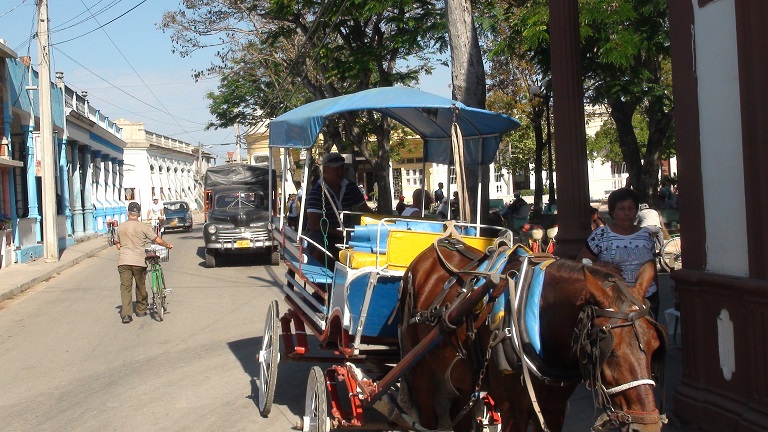
A horse and carriage waits for passengers in dowtown Las Tunas.
Camaguey, Cuba‘s 3rd largest city, is further en-route. The center has nice buildings but the life inside is even more interesting. Factories and schools, National Peso shops with few goods, kindergartens and people homes are all windowless and with doors left open – to provide inhabitants with ventilation and views. When I would look inside some single-storied edifice I would likely see somebody staring outside from a chair or external stairs. In a country where supposedly everybody has a job, it is quite surprising to see thousands of people sitting at their homes throughout weekdays.
Sanctu Spiritus, the next provincial capital is where we spend a night. The town center is nicely restored by Cuban standards. Among the buildings, there is a Masonic lodge. Having participated in the war which won Cuban independence the Freemasons are somewhat tolerated in Cuba unlike in most other non-democratic countries. Typically the door is left open. But only an extremely long flight of stairs is visible as the Lodge itself is on the upper floor.
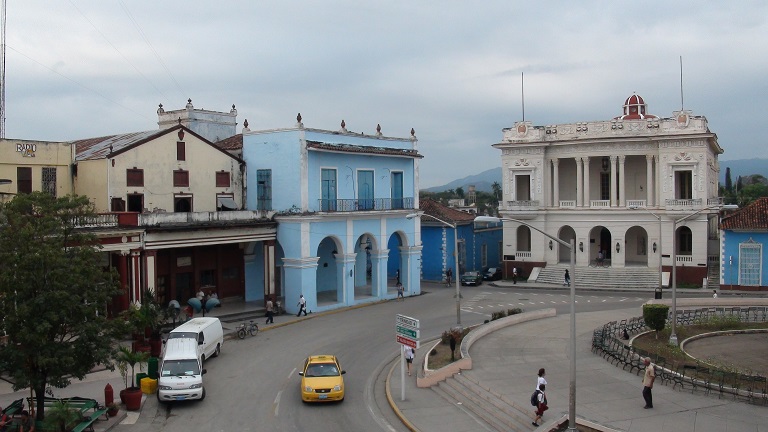
Central square at Sanctu Spiritus.
Sugar plantations that brought Cuba its first riches
In Camaguey, a tout of some remote paladar told us that Trinidad is the prettiest city of Cuba. The entrance to this formerly rich sugar port feels different as its entire center is cobbled and almost devoid of cars blocked by manned movable barriers. For some reason we are allowed to drive in – are there laxer rules for tourists here as well?

A band of musicians performs for tourists in Trinidad restaurant. Every Cuban city has a state-owned Casa De La Trova where performaces are aimed more at the locals. Musician on the right wears Granma baseball cap.
The town is famous for its buildings: their enormous wooden doors, external wooden (18th century) or elaborate metal (19th century) grates. In essence, this does not differ from historic small town architecture elsewhere in Cuba. I visit a museum dedicated to this style that houses a nice 19th-century shower which must have been quite a technological achievement back then and has an extensive yard. Among the exhibits, a friend of ticket seller is privately offering her own crafts. We don’t buy.

Trinidad central square.
Trinidad is supposed to be surrounded by former sugar plantations or ingenios. We visit Valle Matanzas, supposedly the most impressive one. A 7 floored 1835 lookout tower is architecturally spectacular indeed. I climb to the top where 19th-century watchmen used to watch hundreds of slaves and ring bells to declare the start and the end of their 12-hour workday. To the end of the horizon, I see hills and villages full of single floored detached homes and an occasional apartment block. Next to them stand gardens and domestic animals (mainly dogs and pigs). Cubans grow some of their food to save part of their meager wages.
If Trinidad is Cuba’s alternative to a European medieval town our next stop – Cienfuegos – surprises us in its sheer magnificence. Another former capital of the sugar region it boasts many mansions of the former tycoons. The coastline south of the city (Punta Gordo) is especially endowed but so is the city center based on a grid layout. And then there are two massive cemeteries where many graves are marked by large all-white sculptures once transported in from Italy.

An old cemetary in Cienfuegos.
For dinner, we went to Santa Clara, an ideologically important city. After its fall to the revolutionaries in the year 1959 Batista fled. That’s why Che Guevarra has been re-interred here after his remains were uncovered in Bolivia in 1997 (where he was killed while attempting to spread the revolution to that country). Guevara’s hopes of communist Latin America failed and Cuba remained his only true victory. Ironically he is now the favorite image of capitalist souvenir sellers. There is even a common scam of “changing” a 3 Convertible Peso banknote into a 3 National Peso banknote – some tourists who are completely unaware of the double currency agree – because the National Peso bears the image of Che.
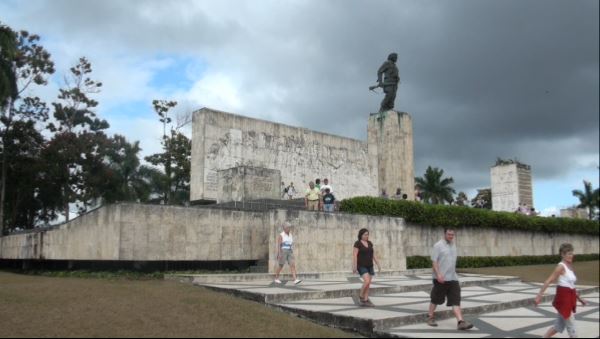
Che Guervarra monument in Santa Clara.
Che’s mausoleum is another concrete monster with his statue on top. The museum was closed but a large plaque bearing Che’s final letter to Fidel is for all to read. Full of “Latin passion” the mentions of love would probably be interpreted in different way than intended in Europe.
Havana, the crumbling yet lavish forbidden capital
We arrive to Havana after sunset. An attempt to see the canonado ceremony at 9PM proves to be belated as we enter the San Pedro fortress (which once guarded this major Spanish port from English and the pirates) too late. On the other side of bay however we see Havana. A dark city as even its impressive Capitolio is not lit. After crossing tunnel to the other side we see many seemingly uninviting districts.

Capitolio of Cuba the next morning.
The next day however we see the true face of the Cuban capital – or perhaps its many faces. A walk brings us to the domed Capitolio (dwarfing even the US one in size) and sculptured National theater, the reminders of the roaring 20s. Behind them stands an old cigar factory. Closed for visits it still has its expensive shop open. Just like Lonely Planet guide suggests before we even enter two people approach us claiming they are factory workers who are paid a part of their wages in cigars and permitted to sell them once a week at cheaper rates. The “official marketplace” they mention turns out to be an apartment in a nearby street. Guidebooks claim such cigars are always faked.
We move on to the old town, the heart of the colonial Havana (in 17th century the largest port in the Americas). We pass crumbling and dirty streets. Havana’s importance is visible in its massive colonial buildings. Sadly many are abandoned or dilapidated, or only the first floor is used for shops and the apartments are evicted. Some are collapsed with merely the extrernal wall remaining.

Massive buildings of Old Havana in a state of disrepair.
Elections are taking place and an electoral circuit is established seemingly at every district in the first floor of some apartment building. Choosing who to vote for isn’t hard as in every constituency there is only one pre-approved candidate standing to be elected to the National Assembly of People’s Power.
As we approach the Plaza Vieja (Old Square) the surroundings suddenly change with every building restored or undergoing restoration by the “historiador office”. With the advent of tourism the government seeks to improve Havana’s image. As the state owns everything it is easy to decide to renovate entire borough (no need to buy out flats or ask the inhabitants). This is in theory as in practice I have never seen a capital city in a sadder general state of repair than Havana. Only several boroughs are renovated. There are simply no resources for anything more.

Impressive Baroque facade of Havana Cathedral.
What is restored is however pretty and what is dilapidated is romantic. This is what draws the tourists in but the locals are also attracted to Havana. Many of its inhabitants are illegals who are pejoratively named “Palestinians” in the local slang. These are not immigrants but fellow Cubans. In Cuba people are not permitted to choose where to live – the government decides this for them. Still many of those refused permit settle in Havana just as their “cousins” sail for the USA. After a week in the rest of Cuba we can see what attracts them. Havana seems to be less poor. Cars are better, there are no lorries that transport people as cattle and there are fewer tandems of horse and carriage. The prices are higher but so are the opportunities.
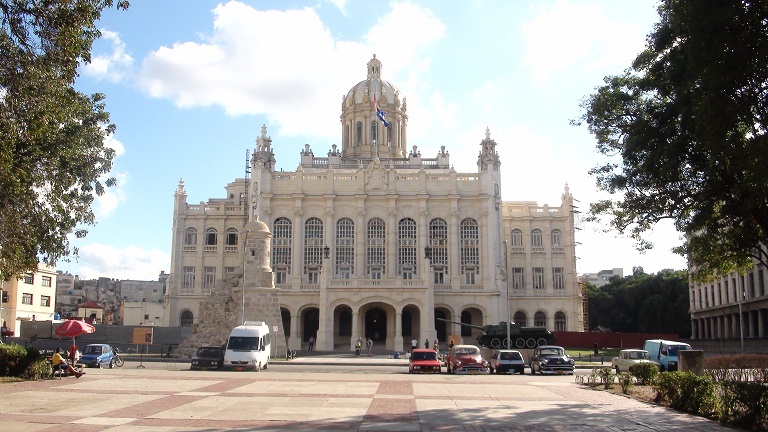
Museum of the Reovlution (formerly the presidencial palace).
In evening we visit Vedado district. Spanish for “The forbidden” it was left empty to offer clear views of the bay in the pirate era but urbanized in the 19th century. Long nationalized crumbling villas of the 19th century elite stand beside truly massive concrete skyscreapers. All the largest ones are not socialist but pre-revolutionary, dating to the 1950s Batista building frenzy. These are Edificio Focsa (still the tallest residential in Cuba) and the Cuba Libre hotel. On the seaside a monument reminds the sinking of ship Maine which brought US into the Cuban independence war against Spain. The historic statue is now joined by a great number of pillars each inscribed with names of international “heroes”. From the 19th century Chicago anarchists to Bolivar and Arafat the pillars honor notable leftists and freedom fighters. Of course a search of Lithuanian freedom fighters would be in vane here as in Cuban government way of thought the Soviet regime was righteous despite committing a genocide and other murders of 50 million people.

Vedado from the balcony of our hotel.
Surprisingly, Havana’s massive Plaza de Revolution is also pre-revolutonary with only the glow-in-the-dark Guevara and Castro plaques added later. In Havana everything worth seeing had been built before 1959. The city must have looked very different back then. Back in the hotel watching the waves that keep crashing into the Malecon (shoreside street) now strolled by merely a few people I imagine how would the country look now if not for the Revolution. Probably it would be some kind of Latin Las Vegas, with neons and LEDs everywhere inviting hordes of American tourists to hundreds of casinos.
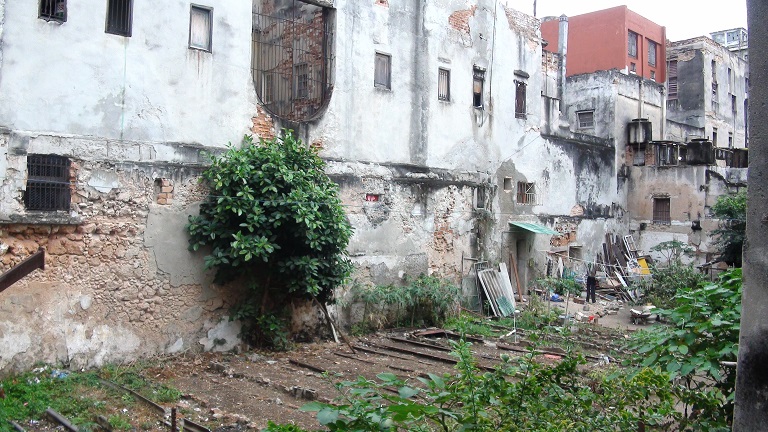
A view through our casa window to a typical Havana yard.
I spend the next morning walking the streets of Havana one last time, wandering further than yesterday and revisiting the key locations. The Cathedral is now unlocked. Afterwards I walk the Malecon. Waves seem to be less furious today and not shower the passers by as happened to one handicapped person I saw yesterday. To the dismay of a bunch of young Russians who seem to wait just for that sitting on the sea wall in swimsuits. Weirdly there are no pedestrian crossings to the Malecon and one must cross a major street to go there.
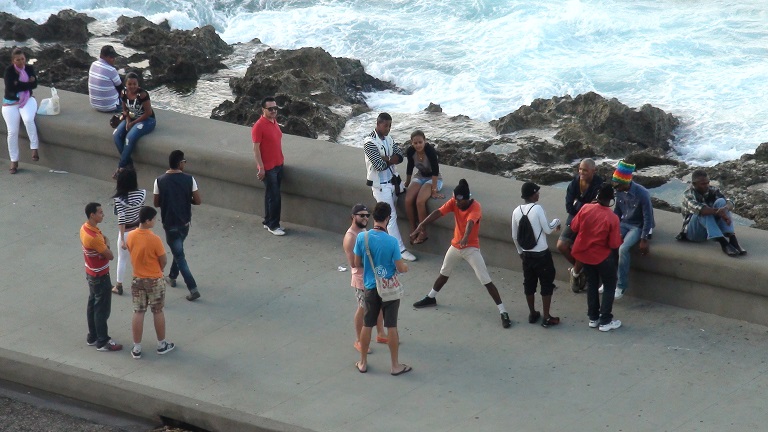
A Jinetero dancing for tourists in Malecon.
Then we drive to Miramar suburb. Once a playground of the rich it still has many of the old villas. Here most of them are restored and have flags waving nearby as this was transformerd to an embassy district. After a lunch we drive at the seaside. A local shopping mall stands here, likely a location o elite Havanian shopping. The Convertible Peso supermarket has little goods however with the same goods covering entire shelves. Like in other shops, “Pringles” chips are in the most important location and they cost here twice as much as in my home country. This is the high standart in Cuba as the National Peso shops are much worse and have even less goods available.
From the patio of Ernesto Hemingway home we catch the final glimpses of Havana. The famous writer surely had a nice place to live. Single floored house cannot be entered. Instead the tourists may see the supposedly authentically placed furniture and things through open windows.

Atmospheric Cuban residence of Ernesto Hemingway.
The Russian resort of Varadero
For a resort of its fame Varadero seems very bleak, especially in the evening. While initially developed as a rich man’s paradise in 1940s modern Varadero consists mainly of socialist era massive hotels. The one we stay at is full of Russians who spend their daytimes on the beach and nights consuming alcohol. “All inclusive” is the only option there even for a single night stay. This is a drawback as the price is larger while the food is scarce even by Cuban standarts (e.g. rotten tomatoes). We were told there was one hotel in the entire resort to offer bet and breakfast but it turned out to be full.

Tourists queing for internet in Varadero. Internet is regulated and slow, and only accessible at certain telecommunications offices.
In the last day of our journey we look around Varadero. The islands of history in the otherwise modern city interest the most. Xanadu Mansion, full of historic furniture, was once the home of the original developers of Varadero and now it is a restaurant and a golf club house. As Varadero is built on a long and narrow peninsula the sea is visible at both sides from the top-floor bar. The views of green fields and turquise sea with some tourists sailing in it might have been possible all those decades ago. All over Varadero the beaches are surprisingly empty.
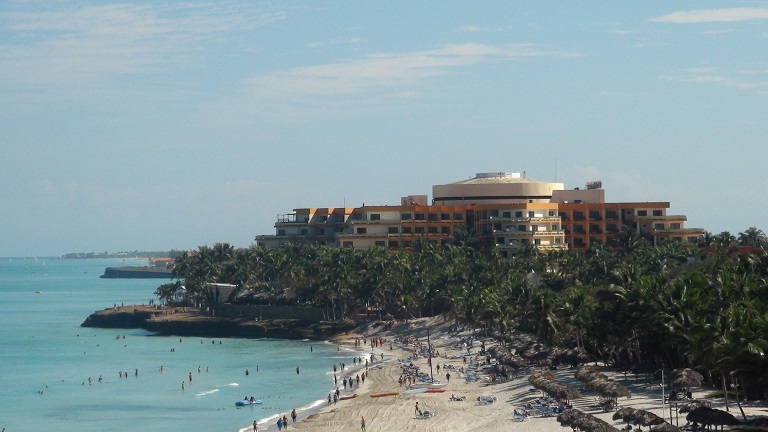
One of the better hotels in Varadero.
Cave of Ambrosio further on should be a historical sight as well with some Native American petroglyphs. However the caretaker aimed his flashlight at them only briefly. More interesting was the large colony of bats of two species hanging on the low “ceiling” and flying around. Some do fear light and fy away once a flashlight is aimed at them. I look through our camera’s infrared option to see that maybe hundreds of bats are constantly flying around heads of the tourist groups. The cave is full of the iconic squeeling sounds.
Josone Park is another oasis of the opulent past in Varadero, however small. A nicely landscapped pond is spanned by pedestrian bridges.

Josone park in Varadero.
The central park of Varadero is worse and the local St. Elvira church is small even by Cuban standarts. As we are preparing to leave we buy some souvenirs. The prices are good in Cuba. I collect national board games of various countries and in Cuba such game is Domino, a set of 54 tiles. There are more people playing baseball than domino but the sound of dominoes crashed to the table by groups of elderly Cubans may also be heard sometimes in Cuban towns. A natural wooden set costed me 8 Convertible Pesos after a short negotiation. Rings, necklaces and other female accessories cost just 1 CUC.
We still have 9 hours until our flight so we go to Cardenas and Matanzas. Both are typical Cuban cities and not as interesting as either Trinidad or Cienfuegos. But they have a convenient location near Varadero so they probably receive even more tourist buses than Trinidad or Santiago. My final peaceful walk in Matanzas was a kind of goodbye to the Carribean island. I passed by exchange office where locals were buying National Pesos for the Convertible Pesos received by tourists. The external doors had no handles – apparently in order to create a job for two men to open and close them. Other locals are buying cheap goods from stores.
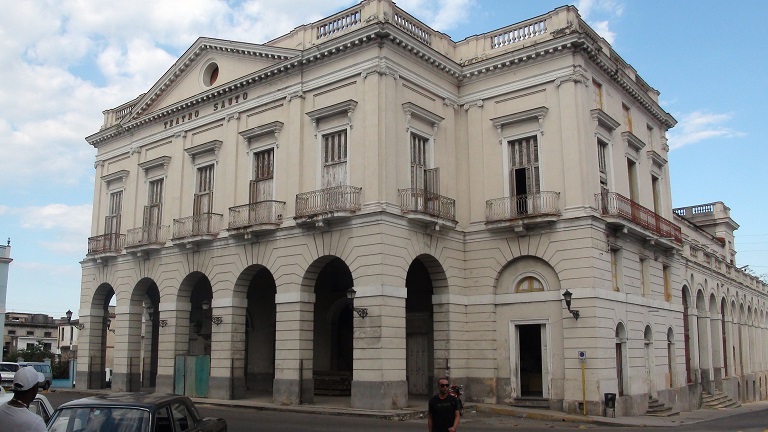
Sauto theater (1863), a famous landmark of Matanzas.
In the heart of Cuba’s tourist industry the locals seem to be even more adept at cheating. After we return to our car a plain-clothed black Cuban claims to be a policeman and our car is supposedly parked illegally – “big trouble” he says and we already anticipate he would ask a “bribe”. We ask for policeman’s ID. He shows his passport ID instead and we drive away. Varadero airport, the only area many tourist see outside the Varadero itself, however is not free of frauds either. In the airport shop the prices are clearly written but when asked to sell some postcards the seller quotes double or triple that number exclaiming that “Those are not prices but numbers of goods”. When we come back there again after a few minutes the “numbers of goods” are already disappeared.
After a long wait in a queue we leave Cuba behind. If I will ever come back here everything will likely be different. The souvenir vendors will still sell Che Guevara shirts and fridge magnets but the system will be dismantled together with its double economy, large public enterprises and inefficient jobs. Some 1950s Chevies and Fords will still drive tourists around but the bulk may be already sold to collectors abroad or scrapped. I am glad I have caught a glimpse of the aging revolutionary Cuba, a unique place and in a sense an ideological dinosaur. There are various forms of tourisms – cultural, historic, gastronomical and genealogical. In Cuba the “sun tourism” predominates but ideological tourism is also interesting.